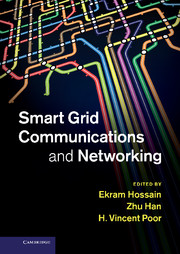Book contents
- Frontmatter
- Contents
- List of contributors
- Preface
- Part I Communication architectures and models for smart grid
- 1 Communication networks in smart grid: an architectural view
- 2 New models for networked control in smart grid
- 3 Demand-side management for smart grid: opportunities and challenges
- 4 Vehicle-to-grid systems: ancillary services and communications
- Part II Physical data communications, access, detection, and estimation techniques for smart grid
- Part III Smart grid and wide-area networks
- Part IV Sensor and actuator networks for smart grid
- Part V Security in smart grid communications and networking
- Part VI Field trials and deployments
- Index
1 - Communication networks in smart grid: an architectural view
from Part I - Communication architectures and models for smart grid
Published online by Cambridge University Press: 05 January 2013
- Frontmatter
- Contents
- List of contributors
- Preface
- Part I Communication architectures and models for smart grid
- 1 Communication networks in smart grid: an architectural view
- 2 New models for networked control in smart grid
- 3 Demand-side management for smart grid: opportunities and challenges
- 4 Vehicle-to-grid systems: ancillary services and communications
- Part II Physical data communications, access, detection, and estimation techniques for smart grid
- Part III Smart grid and wide-area networks
- Part IV Sensor and actuator networks for smart grid
- Part V Security in smart grid communications and networking
- Part VI Field trials and deployments
- Index
Summary
Introduction
The existing electrical grid needs to be smarter in order to provide an economical, reliable, and sustainable supply of electricity [1]. Although the current electrical grid has served well in providing the necessary power supply of electricity, the growing demand, fast depletion of primary energy resources, unreliability, and impact on the environment must be responded to in a vision of the future [2]. This vision is being realized using smart grid, which is a user-centric system that will elevate the conventional electrical grid system to one that functions more cooperatively, responsively, economically, and organically [1].
One of the most important features of smart grid technology that makes it smart or smarter than the current grid is the integration of bi-directional flow of information along with electricity, which can be used to provide effective and controlled power generation and consumption [3]. This two-way flow of information in turn enables active participation of consumers, thus empowering them to control and manage their own electricity usage by providing near real-time information on their electric consumption and associated cost. Due to this overlaid communication infrastructure, smart grid will incorporate into the grid the benefits of distributed computing and communications, which would provide the necessary intelligence to instantaneously balance the supply and demand at the device level. Clearly, modern communication and information technology will play an important role in managing, controlling, and optimizing different functional and smart devices and systems in a smart grid. A flexible framework is required to ensure the collection of timely and accurate information from various aspects of generation, transmission, distribution, and user networks to provide continuous and reliable operation [4].
Information
- Type
- Chapter
- Information
- Smart Grid Communications and Networking , pp. 3 - 33Publisher: Cambridge University PressPrint publication year: 2012
Accessibility standard: Unknown
Why this information is here
This section outlines the accessibility features of this content - including support for screen readers, full keyboard navigation and high-contrast display options. This may not be relevant for you.Accessibility Information
- 1
- Cited by
